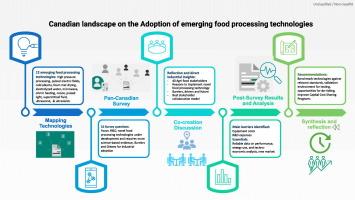Industrial adoption of emerging food processing technologies: Insights from the Canadian agri-food sector
IF 6.8
1区 农林科学
Q1 FOOD SCIENCE & TECHNOLOGY
Innovative Food Science & Emerging Technologies
Pub Date : 2025-09-01
DOI:10.1016/j.ifset.2025.104207
引用次数: 0
Abstract
This project aimed to gather practical insights into the industrial adoption of 12 emerging food processing technologies: high pressure processing, pulsed electric fields, cold plasma, foam mat drying, electrolyzed water, microwave, ohmic heating, ozone, pulsed light, supercritical fluid extraction, ultrasound, and ultraviolet light. This was achieved through an online survey conducted in the Canadian agri-food sector where ten questions were asked and a co-creation workshop with key stakeholders within the food industry were asked to prioritize the findings. The collaborative approach was designed to leverage diverse expertise to support innovation in food processing. Key findings reflect the predominance of CEOs and business owners among survey respondents, highlighting the influence of decision-makers. Small and start-up companies were the most represented across various food sectors. Notably, start-ups appeared more inclined to adopt emerging technologies, probably due to their agility and innovation-driven culture. Cold plasma, pulsed electric fields, and supercritical fluid extraction were identified as the ones requiring more science-supported data. Microwave, ozone, and ultraviolet light were seen as more mature, while ohmic heating, ultrasound, and electrolyzed water were less commonly mentioned, indicating earlier stages of adoption. Major barriers to adoption included high equipment and maintenance costs, R&D expenses, and limited government financial support. Reliable data on performance, energy use, and techno-economic analysis were deemed crucial for scaling technologies to commercial readiness. These insights can guide research, policy, and investment to support sustainable innovation in the agri-food sector.

新兴食品加工技术的工业采用:来自加拿大农业食品部门的见解
该项目旨在收集12种新兴食品加工技术的工业应用的实际见解:高压加工、脉冲电场、冷等离子体、泡沫垫干燥、电解水、微波、欧姆加热、臭氧、脉冲光、超临界流体萃取、超声波和紫外线。这是通过在加拿大农业食品部门进行的在线调查实现的,其中提出了十个问题,并要求与食品行业内的主要利益相关者共同创建研讨会优先考虑调查结果。合作方式旨在利用不同的专业知识来支持食品加工的创新。主要调查结果反映了ceo和企业主在受访者中占主导地位,突出了决策者的影响力。在各个食品行业中,小型和初创公司的代表性最强。值得注意的是,初创企业似乎更倾向于采用新兴技术,这可能是由于它们的敏捷性和创新驱动的文化。冷等离子体、脉冲电场和超临界流体萃取被确定为需要更多科学支持数据的领域。微波、臭氧和紫外线被认为是更成熟的,而欧姆加热、超声波和电解水则较少被提及,这表明采用阶段较早。采用的主要障碍包括高昂的设备和维护成本、研发费用和有限的政府财政支持。关于性能、能源使用和技术经济分析的可靠数据被认为是将技术扩展到商业就绪的关键。这些见解可以指导研究、政策和投资,以支持农业食品部门的可持续创新。
本文章由计算机程序翻译,如有差异,请以英文原文为准。
求助全文
约1分钟内获得全文
求助全文
来源期刊
CiteScore
12.00
自引率
6.10%
发文量
259
审稿时长
25 days
期刊介绍:
Innovative Food Science and Emerging Technologies (IFSET) aims to provide the highest quality original contributions and few, mainly upon invitation, reviews on and highly innovative developments in food science and emerging food process technologies. The significance of the results either for the science community or for industrial R&D groups must be specified. Papers submitted must be of highest scientific quality and only those advancing current scientific knowledge and understanding or with technical relevance will be considered.

 求助内容:
求助内容: 应助结果提醒方式:
应助结果提醒方式:


